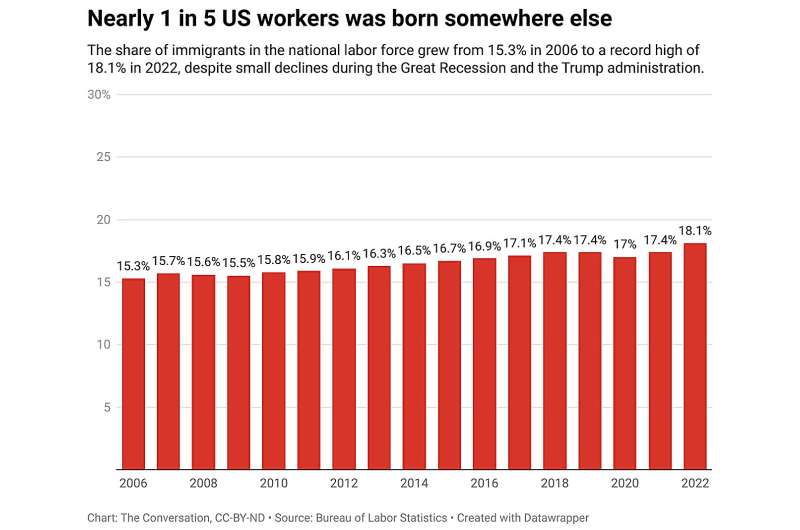Researcher: Immigrants do work that might not otherwise get done, bolstering the US economy

Although Congress is failing to pass laws to restrict the number of migrants arriving in the U.S., a majority of Americans—about 6 in 10— along the Mexico-U.S. border. Politicians who want fewer people to move here often cast those arriving without prior authorization as a .
As an , I'm and research findings contradict those arguments.
The U.S. is that is likely to last well into the future as the U.S.-born population gets older overall, .
Rather than a drain on the economy, an uptick in immigration presents an opportunity to alleviate this shortage. Data from and studies conducted by other scholars shows that immigrant workers in the U.S. are more likely to be active in the labor market—either employed or looking for work—and tend to the most unmet demand.
Help really wanted
The U.S. had in December 2023, according to the Bureau of Labor Statistics. The government agency also found that there were actively seeking paid work.
Economists generally compare the two numbers to calculate the labor shortage. It currently stands at nearly 3 million workers, and the bureau expects this gap to grow as over the next decade.
In other words, the U.S. faces a long-term shortage of people looking for employment.
That shortfall would be much bigger without foreign-born workers, who accounted for a of the U.S. civilian labor force in 2022, according to the Bureau of Labor Statistics.
More likely to be active in the workforce
Another reason why immigrants can help fill that big hole in the U.S. labor market is that so many of them tend to be employed or are looking for work.
About were either employed or actively looking for work as of 2022, in comparison to 61.5% of people born in the U.S.
This difference has been , according to research by the Peterson Foundation, a think tank that focuses on long-term budget problems.
In a , I found that immigrants who arrive in the United States as refugees fleeing violence and persecution in their home countries are eventually more likely to be employed or looking for work than people who are born in the U.S.
More home health aides and janitors
Some of the labor market's biggest shortages are especially acute in professions that tend to attract immigrants, such as home health aides.
The health care and social services sector as a whole has about open jobs, the largest number of job openings currently available.
This is followed by professional and business services with 1.7 million open jobs. This , including cleaning and grounds maintenance.
Currently, about in one of those two high-demand categories or another service occupation.
Making it easier to age in place
A team of economists has found that the than average in places with large numbers of immigrant service workers. This in turn makes it more likely that older adults can avoid institutionalization and stay in their own homes.
But, to be sure, immigrant workers providing these vital community support services often working conditions.
The labor market data not only makes it clear that the U.S. economy can absorb large numbers of immigrants, but it shows that these newcomers could be a much-needed solution to a labor supply crisis.
And yet people arriving in the U.S. as political asylum applicants are enduring , which is delaying their entry into the workforce.
Wouldn't it make more sense for Congress to expand pathways for legal employment access for migrants? From an economic perspective, that seems to be the most prudent course of action.
Provided by The Conversation
This article is republished from under a Creative Commons license. Read the .![]()





















